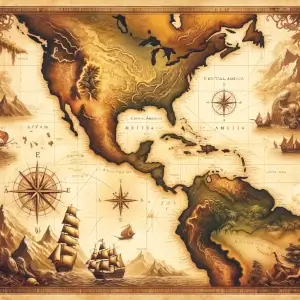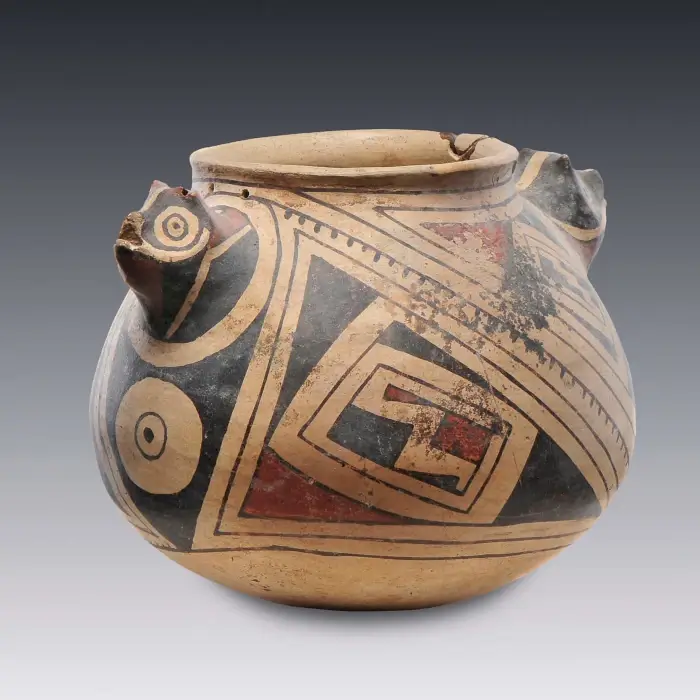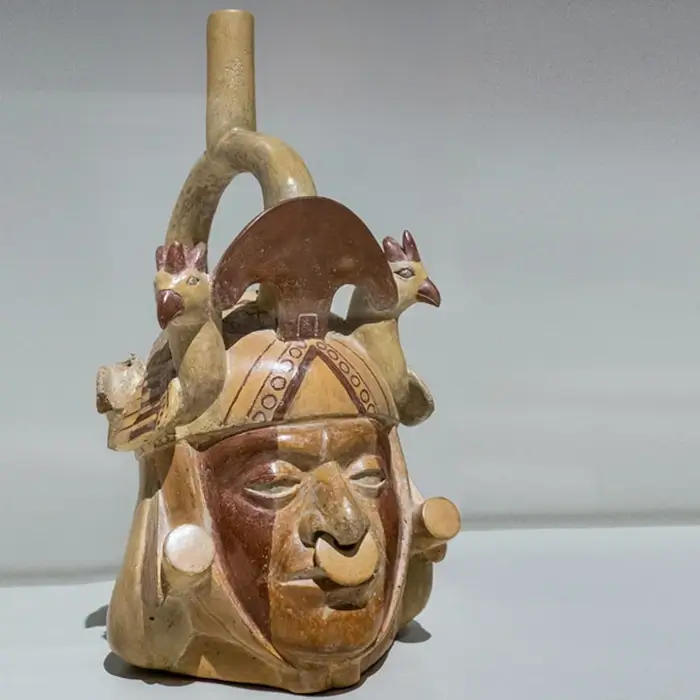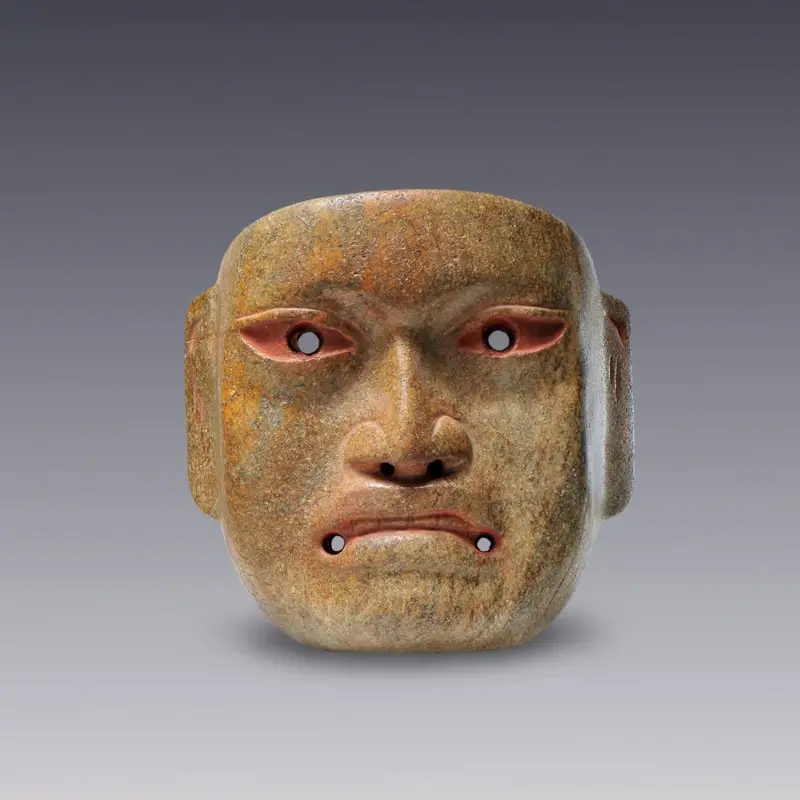Cuicuilco pottery: the art that survived the volcano
Cuicuilco pottery not only reflects the artistic skill of its creators but also tells the story of a civilization that thrived in the shadow of an active volcano. This legacy, shaped by both astronomical influence and the Xitle catastrophe, offers a unique perspective on how nature and the cosmos intertwined in the cultural fabric of Cuicuilco.
Throughout this article, we will unravel how daily life, celestial veneration and resilience in the face of natural disasters were embodied in Cuicuilcan ceramics, revealing a fascinating story of adaptation and survival.
- The great circular base of Cuicuilco
- The incredible astronomy of Cuicuilco and its influence on pre-Columbian Mesoamerica
- The devastating eruption of the Xitle volcano and its consequences for Cuicuilco
- Cuicuilco pottery: The clay treasure under the volcano.
- Daily life in Cuicuilco: between craftsmanship, agriculture and rituality

The great circular base of Cuicuilco
The great circular foundation of Cuicuilco, with an estimated population of 20,000, stands as the first major settlement in Mesoamerica, marking a milestone in pre-Hispanic architecture. This temple, dating from around 600 to 200 B.C., exhibits a unique circular structure, a precursor to the future pyramidal monuments that would dominate the landscape of sites such as Teotihuacán, the great Maya cities and the Aztec capital Tenochtitlán.
Cuicuilco’s strategic location, near the Toluca pass and the shores of Lake Texcoco, played a crucial role in its development, turning it into a regional urban center around 150 B.C. However, its growth was truncated by the eruption of the Xitle volcano, which covered the city with a layer of lava, preserving part of its structures under meters of this volcanic material.
A stone altar, part of a dual structure of the temple, was found at the top of the foundation, which was aligned with the sun during the equinox, suggesting the astronomical and ritual importance of this site. The presence of red pigment on the altar indicates its use in sacrificial ceremonies.
In addition, the Cuicuilco pottery found in the excavations reveals a diversity of influences, from Olmec to Teotihuacan, showing the cultural richness and exchange that characterized this ancient civilization.
The importance of Cuicuilco’s circular plinth extends beyond its architecture; it represents a key link in the understanding of cultural and religious development in Mesoamerica. As we continue to explore this article, we will see how Cuicuilco’s astronomical and architectural influence left a lasting legacy that is reflected in the practices and beliefs of the civilizations that followed.
The Cuicuilco pottery, with its rich symbology and technique, is a testimony to the complexity and sophistication of this culture, which although it was covered by the lava of the Xitle, continues to reveal its secrets through the remains found by modern archaeology, helping us to understand the ceramics of pre-Columbian America.
The incredible astronomy of Cuicuilco and its influence on pre-Columbian Mesoamerica
Mesoamerican architecture reflects a deep integration of astronomical and religious concepts, designed to align and resonate with significant celestial events. This intersection between heaven and earth materialized in the precise orientation of pyramids and temples to capture light effects on specific days, marking crucial moments in the Mesoamerican astronomical calendar.
One of the most emblematic examples of this symbiosis is the pyramid of “El Castillo” in Chichén Itzá, where a play of light and shadow is observed around the equinoxes, although this phenomenon may not have been intentional to commemorate these dates.
The orientation of many Mesoamerican structures, often aligned approximately 15° east of north, points to an intention to mark sunset on August 13, the inaugural date of the Maya Long Count calendar. This orientation pattern not only served to mark crucial solar events but also facilitated the creation of observational calendars to predict important dates for agriculture and ritual activities.

Where was each pre-Columbian culture?
Check our interactive map to see its period and location.
The spatial layout of the cities, with public plazas surrounded by imposing pyramids and temples, served as the setting for ceremonies and festivities that reinforced the Mesoamerican worldview and social structure.
This harmony between architecture and astronomy underscores the sophistication and depth of Mesoamerican knowledge, which saw in the construction of their cities and temples a way to replicate and connect with the divine order of the universe. These principles, embodied in the monumentality of places like Teotihuacán and Tenochtitlán, reveal not only the technical mastery of these peoples but also their search for a balance between the natural environment, the cosmos and spiritual life.
The devastating eruption of the Xitle volcano and its consequences for Cuicuilco
The eruption of the Xitle volcano, a catastrophic event in the pre-Columbian history of Central Mexico, profoundly transformed the landscape and the lives of ancient civilizations in the region. This event, which occurred between 245 and 315 A.D., released lava flows that swept northward across the terrain, burying cities such as Cuicuilco under a thick layer of basaltic lava. The magnitude of this eruption and the extent of the lava field, known today as Pedregal de San Angel, covered approximately 80 km², highlighting the immense force of nature at work.
The consequences of the Xitle eruption were immediate and dramatic, marking the end of Cuicuilco as an urban and ceremonial center. This disaster not only caused the destruction of infrastructure and loss of life, but also triggered migratory movements to areas such as Toluca and Teotihuacán, propelling the latter to become the dominant power in the Valley of Mexico. Despite the devastation, Cuicuilco’s relevance persisted in collective memory, and later generations returned to the site for religious reasons, suggesting a deep spiritual connection to the place despite its destruction.
The Xitle eruption is not only a testament to the geological volatility of the region but also offers valuable lessons about the resilience and adaptability of ancient cultures in the face of natural disasters. Archaeological investigations have revealed that, despite the tragedy, the affected communities found ways to reorganize and continue their traditions, as evidenced by the offerings and artifacts left in the area long after the eruption. This chapter in the history of Mesoamerica highlights the dynamic interaction between humans and their environment, and how catastrophic events can alter the course of human history.
Cuicuilco pottery: The clay treasure under the volcano.
The ceramic art of Cuicuilco not only stands out for its aesthetic beauty but also for its profound symbolism and the advanced technique with which these pieces were created. Through archaeological findings, it has been determined that the occupation of Cuicuilco continued even after the devastating eruption of the Xitle, covering Classic, Epiclassic, Postclassic periods until the Spanish conquest, although the importance of the site and the number of inhabitants decreased significantly.
The ceramic materials found at Cuicuilco offer a window into the past, showing not only domestic objects such as pans, pots, jars, plates, boxes and comales, but also ritual elements such as fragments of braziers, miniature pieces and Tlaloc vessels, indicating that these were thrown into the water as offerings in rituals, an act that resonates with practices recorded by Spanish chroniclers in other parts of Postclassic Mexico.

Buy pre-Columbian ceramics
Find original pieces and also reproductions identical to the traditional ceramic works that were made in pre-Columbian America and that are only found in museums, making them affordable.
The ceramics of Cuicuilco, with its phases associated with the apogee of Teotihuacán during the Classic period, reflect the influence and integration of diverse traditions and techniques over time. This cultural exchange is evident in the predominant types temporally located in the Epiclassic period, under the Coyotlatelco tradition, contemporary with the occupation of Tula Chico, as well as other important settlements in the Valley of Mexico. The ceramic art of Cuicuilco, therefore, is not only testimony to the adaptability and resilience of its inhabitants in the face of natural catastrophes, but also to a very rich cultural exchange that enriched their artistic expression.
Daily life in Cuicuilco: between craftsmanship, agriculture and rituality
Daily life in Cuicuilco unfolded in a context marked by the proximity of unpredictable natural phenomena, such as the volcanic activity of Cerro Xitle. This constant threat profoundly influenced the cosmovision of its inhabitants, who developed ritual practices to try to mediate and regulate these natural forces. The deity most associated with Cuicuilco was Huehuetéotl, the Old God of Fire, reflecting the importance of the fire element in their spiritual and daily life.
The social and religious structure of Cuicuilco was articulated around its civic-ceremonial center, dominated by a truncated cone pyramid, which was the heart of the community. Excavations have revealed that the top of the pyramid housed a stone altar with traces of red pigment, suggesting the practice of ritual sacrifice during religious ceremonies. This sacrificial practice evidences the importance of rituality in connecting with the divine and nature.
Agriculture played a central role in the subsistence of Cuicuilco, with maize as the mainstay of their diet and economy. The relationship with the environment and natural cycles was deeply integrated into their lives, reflecting a profound knowledge of the cosmos, which was manifested in the organization of their ritual and agricultural calendar. Astronomical observation was vital for determining planting and harvesting times, as well as for planning civic and religious events, reflecting a life in harmony with the universe.





